
Gosho-ha Hyoho Niten Ichi-ryu
Encyclopedia
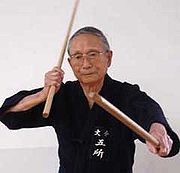
Hyoho Niten Ichi-ryu
, which can be loosely translated as "the school of the strategy of two heavens as one", is a koryū , transmitting a style of classical Japanese swordsmanship conceived by the warrior Miyamoto Musashi...
, the Kenjutsu
Kenjutsu
, meaning "the method, or technique, of the sword." This is opposed to kendo, which means the way of the sword. Kenjutsu is the umbrella term for all traditional schools of Japanese swordsmanship, in particular those that predate the Meiji Restoration...
school created by Miyamoto Musashi
Miyamoto Musashi
, also known as Shinmen Takezō, Miyamoto Bennosuke or, by his Buddhist name, Niten Dōraku, was a Japanese swordsman and rōnin. Musashi, as he was often simply known, became renowned through stories of his excellent swordsmanship in numerous duels, even from a very young age...
, under the supervision of Gosho Motoharu
Gosho Motoharu
Gosho Motoharu 五所 元治 is one prominent master of the traditional Samurai arts, Koryu Budo or Kobudo. Shihan , of the schools Niten Ichi Ryu and Sekiguchi Ryu. Has Menkyo kaiden, in both schools. Is also Iaido Hachidan and Kendo Nanadan...
, Shihan of the 9th generation. Since April 2007 was reintegrated with the seito (main line) under Yoshimoti Kiyoshi, 12th successor of Hyōhō Niten Ichi-ryū and 10th successor of Gosho-ha Hyōhō Niten Ichi-ryū.
About the ryū
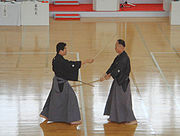
Soke
The word soke has several meanings:* Soke , an early Western jurisdictional concept.* Soke or eke is a Tongan stick dance, originating from Wallis and Futuna., a Japanese title meaning "head of the family," and is usually used to denote the headmaster of a school of Japanese martial arts.* Soke of...
(headmaster), Aoki Kikuo.
In 1961, Aoki Kikuo named one of his closest disciples, Gosho Motoharu, as Shihan (master responsible for teaching the techniques of the ryū) and Soke Daiken (adjunct successor) of the 9th generation, and other disciple, Kiyonaga Tadanao, as 9th Soke, with the goal to make sure that the techniques of the style were passed to the future generations. Before, in 1955, Gosho Motoharu had received Menkyo kaiden, the license of total transmission in Hyōhō Niten Ichi-ryū and Sekiguchi-ryū, the two schools that Aoki Kikuo was headmaster.
Aoki Kikuo died in 1967. In the following years, the two masters continued representing the Niten Ichi-ryū in Japan.

Kendo
, meaning "Way of The Sword", is a modern Japanese martial art of sword-fighting based on traditional Japanese swordsmanship, or kenjutsu.Kendo is a physically and mentally challenging activity that combines strong martial arts values with sport-like physical elements.-Practitioners:Practitioners...
teacher of the same town, who made contact with the style months earlier interested in learning more about the Bōjutsu
Bojutsu
, translated from Japanese as "staff technique", is the martial art of using a staff weapon called bō which simply means "staff". Staffs are perhaps one of the earliest weapons used by humankind. They have been in use for thousands of years in Eastern Asia. Some techniques involve slashing,...
of the Niten Ichi-ryū, to stay as 10th soke, while the son of the 9th Soke, Kiyonaga Fumiya, would be the 11th soke.
Gosho Motoharu taught to Imai Massayuke and Kiyonaga Fumiya all the curriculum of the ryū in the following months and years, and remained as the main responsible for the techniques teachings. Together, they represented the ryū on many occasions and countries, such as France (1983), China (1986) and Australia (1988).
In the end of the 1980s, the 10th Soke and the Shihan splintered their ways. At this time, Gosho Motoharu was graded as Iaido Hanshi Hachidan by the ZNIR, and was also responsible for Sekiguchi-ryū. Imai Massayuke did not received Menkyo Kaiden in Hyōhō Niten Ichi-ryū from Gosho Motoharu, thus breaking the Menkyo Kaiden transmission.
At this time, there were changes in the kata of the ryū under Imai Massayuke. The techniques of the style became different of the style as taught by Aoki Kikuo. One of the best know record of the original techniques is the Nippon Budokan
Nippon Budokan
The , often shortened to simply Budokan, is an indoor arena in central Tokyo, Japan.This is the location where many "Live at the Budokan" albums were recorded...
Archive, recorded in 1981 with Gosho Motoharu acting as Uchidachi
Uchidachi
means "striking/attacking sword" and is one of the two roles in kata of budō and bujutsu, the other being shidachi .The senior party is normally uchidachi...
and the 10th Soke, Imai Massayuke, as Shidachi
Shidachi
means "doing/receiving sword" and is one of the two roles in kata of budō and bujutsu, the other being uchidachi . In modern Kendo this is normally written ....
.

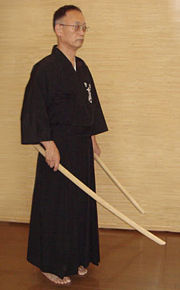
In November 2003, Imai Massayuke decided that the title soke would no more be used in the ryū, and that there would be three 11th generations successors, who would be named as dai juichi. They were Kiyonaga Fumiya (son of the 9th Soke, Kiyonaga Tadanao) of Oita, Chin Kin (an old student of the 8th Soke, Aoki Kikuo) and Iwami Toshio from Kokura.
Imai-soke put the Jisso Emman no Bokuto, the wooden sword made by Miyamoto Musashi and traditional symbol of his successor, in guard of the Usa Jingu Shrine. Any of the daijuichi or their future successors have access to it by a limited period of time.
In 2004 Kiyonaga Fumiya (dai juichi) died. Most of the ryū members in Japan were his students and decided not to continue under the others successors, but to join Gosho Motoharu in order to give continuity to the original forms of the style.
So was founded the branch Gosho-ha Hyōhō Niten Ichi-ryū in 2004, with members in Japan, Brazil, Argentina, Hawaii and Chile.
The 10th soke, Imai Massayuke, died in 2006. In May 2007 the Oita Prefecture Kendo Department requested the Kiyonaga family and the Gosho Ha Niten Ichi-ryū masters to reestablish the seito (main line) of Kiyonaga Fumiya in Oita, where the ryū was based since the 9th generation. The Kiyonaga family designated Yoshimoti Kiyoshi, son of Gosho Motoharu and successor in Gosho-ha Hyōhō Niten Ichi-ryū, as Junidai (12th successor) of Hyōhō Niten Ichi-ryū Seito under Kiyonaga Fumiya's line.
The two lines were again unified under Yoshimoti Kiyoshi, 12th successor of Miyamoto Musashi, from a unbroken line in both Menkyo Kaiden transmission and recognized succession.
Others masters of the ryū under Yoshimoti Kiyoshi and Gosho Motoharu are Ishii Toyozumi and Shigematsu Isao in Japan (among others).
The two remaining successors of Imai Massayuke continue to represent the ryū with their own groups.
Dispute
Iwami Toshio, one of the three daijuichi successors, disputes the sole representation of Hyōhō Niten Ichi-ryū, not recognizing the two other seito lines. His group alleges that Imai Massayuke changed his mind about having three successors after the decision of Kiyonaga Fumiya to follow without further contact with him and Iwami Toshio.This group also alleges that Gosho Motoharu cold not establish his family line (Gosho Ha) without the sanction of the present Soke. To this, the group of Gosho Motoharu and Yoshimoti Kyoshi responded that Gosho is Shihan of the 9th generation. They also don't recognize the status of Iwami Toshio as present Soke.
The title of soke is usually designated from one leader to the next. It is not a hereditary title in Hyōhō Niten Ichi-ryū. In 2003 Imai Massayuke, the 10th Soke, decided to end the use of this title in the ryū, a fact recognized by Nihon Kobudo Kyokai.
The legitimacy of succession by Yoshimoti is recognized by the Japanese budo community. In 2007, the year of the succession, he represented the ryū in some of the most important events of Japan, such as the Kyoto Taikai and the All Japan Naginata Championship.
In September 2007 the Kendo Nippon, the most important publication of Japan about the Sword Arts made a extensive report covering the succession by Yoshimoti.
About the changes in the katas made by Imai Massayuke, the Iwami Toshio's groups says that Imai Massaiyuke amalgamated and simplified the techniques for technical and didactic reasons. They carry on this altered version of the katas in their demonstrations, practices and seminars.
The group of Gosho Motoharu and Yoshimoti Kyoshi practices the original form of the kata as they were taught by the 8th soke. This group emphasizes the importance of preserving the essence and form of the techniques unchanged.
Lineage
Per www.nitenichiryu.jp.
Seito Hyōhō Niten Ichi-ryū
Shinmen Musashi no Kami Fujiwara no Genshin (Miyamoto Musashi) 宮本 武蔵 藤原 玄信-
-
- ||
-
Terao Kyūmanosuke Nobuyuki 寺尾 求馬助
-
-
- ||
-
Terao Gouemon Katsuyuki 寺尾 郷右衛門
-
-
- ||
-
Yoshida Josetsu Masahiro 吉田 如雪
-
-
- ||
-
Santō Hikozaemon Kiyohide 山東 彦左衛門
-
-
- ||
-
Santō Hanbē Kiyoaki 山東 半兵衛
-
-
- ||
-
Santō Shinjūrō Kiyotake 山東 新十郎
-
-
- ||
-
Aoki Kikuo Hisakatsu 青木 規矩男
-
-
- ||
-
Kiyonaga Tadanao 清長 忠直
-
-
- ||
-
Imai Masayuki 今井 正之
-
-
- ||
-
Kiyonaga Fumiya 清長 忠直
-
-
- ||
-
Yoshimoti (Yoshimochi) Kiyoshi (10th successor Gosho-ha Hyōhō Niten Ichi-ryū) 吉用 清
Gosho-ha Hyōhō Niten Ichi-ryū
Shinmen Musashi no Kami Fujiwara no Genshin (Miyamoto Musashi) 宮本 武蔵 藤原 玄信-
-
- ||
-
Terao Kyūmanosuke Nobuyuki 寺尾 求馬助
-
-
- ||
-
Terao Gouemon Katsuyuki 寺尾 郷右衛門
-
-
- ||
-
Yoshida Josetsu Masahiro 吉田 如雪
-
-
- ||
-
Santō Hikozaemon Kiyohide 山東 彦左衛門
-
-
- ||
-
Santō Hanbē Kiyoaki 山東 半兵衛
-
-
- ||
-
Santō Shinjūrō Kiyotake 山東 新十郎
-
-
- ||
-
Aoki Kikuo Hisakatsu 青木 規矩男
-
-
- ||
-
Gosho Motoharu 五所 元治
-
-
- ||
-
Yoshimoti (Yoshimochi) Kiyoshi (12th successor Seito line) 吉用 清
Techniques
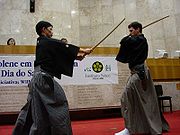
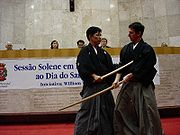
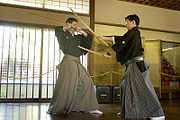
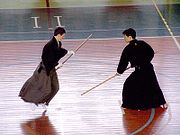
Gosho Motoharu and Yoshimoti Kiyoshi preserves these techniques as they arrived the 20th century with the 8th Sōke, Aoki Kikuo.
The Bokutō (wooden sword) used have unique attributes. They are made following the model of a Bokutō made by Miyamoto Musashi himself. Today in possession of the Usa Shrine (宇佐神宮) in Ōita, where the Hyōhō Niten Ichi-ryū members annually perform embu (demonstration) at the commemoration of the new year.
The ryū has the following techniques:
Tachi Seihō 太刀勢法—12 techniques with long sword
- Sassen
- Hassō Hidari
- Hassō Migi
- Uke Nagashi Hidari
- Uke Nagashi Migi
- Moji Gamae
- Haritsuke
- Nagashi Uchi
- Tora Buri
- Kazuki
- Aisen Uchidome
- Amashi Uchi
Kodachi Seihō 小太刀勢法—seven techniques with short sword
- Sassen
- Chūdan
- Uke Nagashi
- Moji Gamae
- Hari Tsuke
- Nagashi Uchi
- Aisen
Nitō Seihō 二刀勢法—five techniques with two swords (mentioned in The Book of Five Rings
The Book of Five Rings
is a text on kenjutsu and the martial arts in general, written by the samurai warrior Miyamoto Musashi circa 1645. There have been various translations made over the years, and it enjoys an audience considerably broader than only that of martial artists: for instance, some business leaders find its...
)
- Chūdan
- Jōdan
- Gedan
- Hidari Waki Gamae
- Migi Waki Gamae
Bōjutsu 棒術—20 techniques with staff
There are also kuden
Kuden
Kuden is a municipality in the district of Dithmarschen, in Schleswig-Holstein, Germany....
teachings, known only by advanced practitioners. These teachings are not other sets of techniques, but other ways to practice the above mentioned techniques.
There are no other weapons in Hyōhō Niten Ichi-ryū besides tachi, kodachi, the two together and bō
Bo
-People:*Bo , name origin, plus people with the name*Bo , name origin, plus people with the surname**Bo , Chinese family names*Bo people , extinct minority population in Southern China famous for hanging coffins...
.
Grades
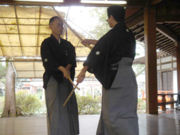
Makimono
A Makimono is a Japanese hand scroll, an ink-and-brush painting or calligraphy which is supposed to be held in the hand and unrolls horizontally....
(scroll) system.
Each Makimono refers to a set of technique. All the licenses must be awarded in order. I.e.: One cannot receive okuden (by learning the two-sword techniques) before learning the long and short swords techniques (receiving Shoden and Chuden makimono).
The transmission of Menkyo Kaiden is the assurance that the ryū has the same form and methods created by the founder. Of the three representatives of the Seito line, Yoshimoti Kiyoshi is the only one who comes from a unbroken line of Menkyo Kaiden transmission.
- Shoden: handed down to those who learned completely the katas of the Tachi Seiho.
- Chuden: after Shoden, handed down to those who learned completely the katas of the Kodachi Seiho.
- Okuden: after Chuden, handed down to those who learned completely the katas of the Nito Seiho.
- Menkyo: After Okuden, handed down to those who learned completely the Bōjutsu katas.
- Menkyo kaiden: handed down to those who assimilated the entire content of the ryū plus have a deep philosophical knowledge of the Way and of the teachings of the founder.
Embu
Yoshimoti Kiyoshi frequently represents the ryū in important embu (demonstrations / 演舞).In 2002 and 2007 he represented the ryū in the Kyoto Taikai, one of the most important events of martial arts in Japan, held every year in the Kyōto Butokuden.
In 2007 Yoshimoti Kiyoshi represent the ryū in other important budō events besides de Kyōto Taikai, such as the All Japan Naginata Championship and the Miyamoto Yori Taikai, in Kokura.
Another important embu, held every year and specially important for the members of the ryū, is the commemoration of the new year at the Usa Jingū Shrine, where the Miyamoto Musashi's bokutō is held.

